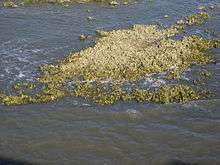Oyster reef

The term oyster reef refers to dense aggregations of oysters that form large colonial communities. Because oyster larvae need to settle on hard substrates, new oyster reefs may form on stone or other hard marine debris. Eventually the oyster reef will propagate by spat settling on the shells of older or nonliving oysters. The dense aggregations of oysters are often referred to as an oyster reef, oyster bed, oyster bank, oyster bottom, or oyster bar interchangeably. These terms are not well defined and often regionally restricted.
Degradation of Oyster Reefs
Crassostrea virginica, the Eastern Oyster, was a major reef builder in the Chesapeake Bay until the late 19th century.[1] Because of overfishing, environmental degradation, and disease, populations of C. virginica underwent a drastic reduction in population size.[1] There is an established pattern connecting human fishing practices to oyster population collapse across the globe. Besides the collapse of C. virginica reefs on the east coast of the United States, populations of the Olympia Oyster, Ostrea lurida, on the western coast of the United States and the Rock Oyster, Saccostrea glomerata, of eastern Australia have both been heavily impacted by harmful fishing practices.[2]
Oyster Reef Ecology
Natural oyster reefs are composed of living and dead oyster shells and provides important habitats for various species.[1] For example, the complex three-dimensional interstitial spaces within oyster reefs provide refugia for prey or juvenile species, which increases prey biomass and thereby enhances trophic transfer. Oyster reefs also stabilize shorelines by promoting sediment deposition and buffering wave energy, thereby allowing other habitats such as sea grass beds and marsh areas to form while simultaneously decreasing erosion of the shoreline.[3][4][5][6]
Ecosystem Services
The filter feeding behavior of oysters can buffer against environmental degradation caused by human induced eutrophication of estuary systems. Oysters feed on suspended phytoplankton and other organic matter. Disruption of the filter feeding by oysters can lead to a decrease in the elimination of organic matter from the water column and increase phytoplankton abundance. This in turn may lead to seasonal anoxia, which could increase mortality for other estuary animals, such as fish.[1]
Oyster reefs can also impact the carbon sequestration and excess nutrient uptake. Oyster reefs also stabilize shorelines by promoting sediment deposition and buffering wave energy, thereby allowing other habitats such as sea grass beds and marsh areas to form while simultaneously decreasing erosion of the shoreline.[3][4][5][6]
Restoration
The topic of oyster reef restoration has gained more attention and support over recent years. Oyster reef restoration projects often place the sanitized shells of dead oysters, concrete, or limestone pieces on a soft bottom to encourage oyster spat settlement.[4] Benefits to restoring these habitats includes suppressing phytoplankton blooms via increasing filter feeding behavior,[7] increase nutrient sequestration and dentrification rates,[8] increase nekton biomass, and potentially increase commercial fishery value.[9] However, finding data on previously implemented restoration projects can be difficult to access, thereby hindering future restoration efforts.[10]
References
- 1 2 3 4 Kirby, Michael X.; Miller, Henry M. (2005-03-01). "Response of a benthic suspension feeder (Crassostrea virginica Gmelin) to three centuries of anthropogenic eutrophication in Chesapeake Bay". Estuarine, Coastal and Shelf Science. 62 (4): 679–689. doi:10.1016/j.ecss.2004.10.004.
- ↑ Kirby, Michael (2004). "Fishing down the coast: Historical expansion and collapse of oyster fisheries along continental margins" (PDF). PNAS. 101: 13096–13099. doi:10.1073/pnas.0405150101.
- 1 2 La Peyre, MK; Furlong, J; Brown, LA; Piazza, BP; Brown, K (2014). "Oyster reef restoration in the northern Gulf of Mexico: extent, methods, and outcomes". Ocean & Coastal Management. 89: 20–28. doi:10.1016/j.ocecoaman.2013.12.002.
- 1 2 3 Brown, LA; Furlong, JN; Brown, KM; La Pyre, MK (2014). "Oyster reef restoration in the northern Gulf of Mexico: effect and artificial substrate and age on nekton and benthic macroinvertebrate assemblage use". Restoration Ecology. 22: 213–222.
- 1 2 Dillon, KS; Peterson, MS; May, CA (2015). "Functional equivalence of constructed and natural intertidal eastern oyster reef habitats in a northern Gulf of Mexico estuary". Marine Ecology Progress Series. 528: 187–203. doi:10.3354/meps11269.
- 1 2 George, LM; De Santiago, K; Palmer, TA; Pollack, JB (2015). "Oyster reef restoration: effect of alternative substrates on oyster recruitment and nekton habitat use". Journal of Coastal Conservation. 19: 13–22. doi:10.1007/s11852-014-0351-y.
- ↑ Gedan, Keryn B.; Kellogg, Lisa; Breitburg, Denise L. (2014-07-01). "Accounting for Multiple Foundation Species in Oyster Reef Restoration Benefits". Restoration Ecology. 22 (4): 517–524. ISSN 1526-100X. doi:10.1111/rec.12107.
- ↑ Kellogg, M. Lisa; Cornwell, Jeffrey C.; Owens, Michael S.; Paynter, Kennedy T. (2013-04-22). "FEATURE ARTICLE Denitrification and nutrient assimilation on a restored oyster reef". Marine Ecology Progress Series. 480: 1–19. doi:10.3354/meps10331.
- ↑ Humphries, Austin T.; Peyre, Megan K. La. "Oyster reef restoration supports increased nekton biomass and potential commercial fishery value". PeerJ. 3: e1111. PMC 4556142
 . PMID 26336635. doi:10.7717/peerj.1111.
. PMID 26336635. doi:10.7717/peerj.1111. - ↑ La Peyre, Megan; Furlong, Jessica; Brown, Laura A.; Piazza, Bryan P.; Brown, Ken (2014-03-01). "Oyster reef restoration in the northern Gulf of Mexico: Extent, methods and outcomes". Ocean & Coastal Management. 89: 20–28. doi:10.1016/j.ocecoaman.2013.12.002.